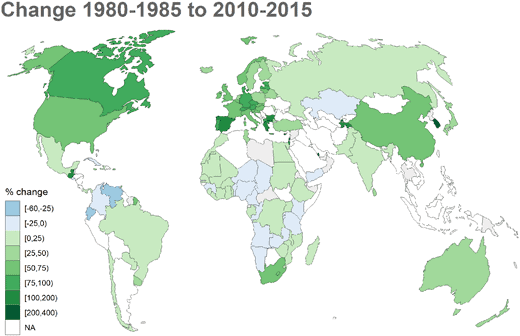
Across the world, more women are giving birth to twins than ever, say scientists who’ve analyzed records of hundreds of millions of births since 1980. Researchers believe that modern fertility techniques and better access to healthcare explain the significant rise in the rate of twins births.
Twins and other multiples have always been fascinating due to their rare occurrence. Doctors and scientists have been studying them for centuries. Psychologists have been at them for years. Hollywood simply loves them. But researchers are still learning new things about twins as time goes on.
There are two types of twins: monozygotic and dizygotic. Monozygotic twins are also known as identical twins because they grow from the same single combination of egg and sperm, so they thereby share the same genetic background. Genetic-wise, they’re essentially identical
Dizygotic (or fraternal twins) form from two or more zygotes, meaning they develop in the womb from separate eggs fertilized by separate sperm. So these twins have each their own unique combination of genes and are basically like any other siblings, with the important distinction that they share a womb during gestation.
Although twins are quite rare among humans, they are the norm for many other mammals. You might have noticed that cats and dogs give birth to multiples like triplets (3), quadruplets (4), quintuplets (5), and even sextuplets (6). It’s just that we call these babies littermates whereas human babies are referred to as fraternal or identical twins.
But although twins and other multiples are rare among humans, they’re starting to occur sensibly more often.
Researchers at the University of Oxford collected and estimated twinning rates for the 2010-2015 period in 165 countries, covering nearly 99% of the world’s population. They also scoured individual survey data and medical literature to obtain twinning rates between 1980 and 1985.

In the 1980s, the twinning rate was about 9.1 per 1,000 deliveries. Today, the rate has increased by a third to about 12 twin deliveries per 1,000 births.
Not all regions of the globe saw a uniform twinning rate. Africa had and still has to this day the highest occurrence of twin births: 17.1 twin births/1,000 deliveries in 2015 compared to 16.5/1,000 in 1980.

Other regions are catching up, however. Europe’s twinning rate jumped from 9.1 to 14.4, while North America and Oceania went from 9.9 to 16.9 and 10.1 to 14.8, respectively. Asia and South America also saw higher twinning rates, but less pronounced as elsewhere, growing from 7.0 to 9.2 and from 8.7 to 9.3, respectively. Asia and Africa are currently home to 80% of all twin deliveries in the world.
It’s important to note that these stats are for fraternal twins. The occurrence of identical twins has remained relatively constant at around 3-4 per 1,000 deliveries.
There are a few reasons that may explain the rise in the twinning rate. Fertility techniques such as in vitro fertilization (IVF) have become increasingly common, and these are known to increase the odds of having twins. So does having children later in life, a trend which has been on the rise, especially in developing countries that have seen a jump in urbanization.
Twin births have also been associated with complications during pregnancy. But improvements in healthcare have mitigated these problems, increasing the survival of twins.
The findings appeared in the journal Human Reproduction.


